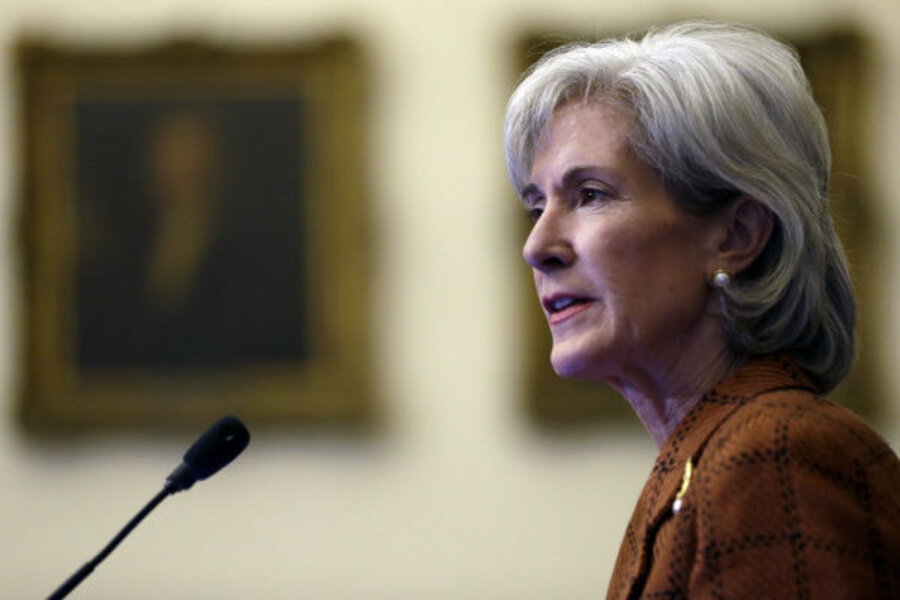'Obamacare' to drive up health-care premiums? Report sets off firestorm.
| Washington
How will the Affordable Care Act affect me?
To many Americans, that is a big question, as the Jan. 1, 2014, implementation date approaches for the individual mandate to purchase insurance and other key provisions of "Obamacare."
The answer depends on several things, starting with whether you get your health insurance through your employer or individually. If it’s through your work, chances are not much will change (though you or your employer could still opt to buy insurance on the new online “exchange”). But if you’re uninsured or currently buying insurance on the individual market, changes are in store.
And the changes could vary dramatically, depending on your demographic profile and what your current plan looks like. Some people who have had bare-bones policies may face higher premiums, says Health and Human Services Secretary Kathleen Sebelius, but that’s because they will have better coverage.
“These folks will be moving into a really fully insured product for the first time, and so there may be a higher cost associated with getting into that market,” the secretary told reporters Tuesday, according to the Wall Street Journal. “But we feel pretty strongly that with subsidies available to a lot of that population that they are really going to see much better benefit for the money that they’re spending.”
Some people’s rates will go up and others will go down, because the law restricts how insurance companies factor in gender and age when setting premiums. So, men and younger people are likely to see their rates go up, while women and older people are likely to see them go down. Insurance companies will also be barred from discriminating based on preexisting conditions.
Secretary Sebelius says it’s too soon to talk specifics about premiums until the insurance companies submit their bids this summer. But she predicts that the online exchanges will encourage competition among insurers and bring premium prices down.
From the perspective of insurance companies, implementation of Obamacare will mean an average increase of 32 percent in the cost of medical claims per person by 2017, according to a study released Tuesday by the Society of Actuaries (SOA). But that figure will vary dramatically state by state, depending on how states handle their high-risk pools, which are then folded into the individual market under the reform. The cost of claims drives the price of health-care premiums.
“The projections in this study suggest that when the dust settles by 2017, we can expect mixed results on the reform bill’s goals of expanding coverage and reducing costs,” says Kristi Bohn, consulting health staff fellow at SOA, in the report.
In the SOA model, what are currently considered “low-cost states,” such as Ohio, Wisconsin, and Indiana, will see a large increase in the cost of medical claims – 80.9 percent for Ohio, 80 percent for Wisconsin, and 67.6 percent for Indiana. But the current “high-cost states” will see the average cost of medical claims go down. The biggest decrease, 13.9 percent, is projected for New York, followed by Massachusetts, with a 12.8 percent decrease.
Under the Affordable Care Act, as many as 32 million Americans will join the insurance rolls, producing a reduction in the ranks of the uninsured from 16.6 percent of the US population to 6.6 percent, the SOA study says.
But on the issue of the 32 percent average increase in the cost of medical claims, the White House is pushing back. At the daily briefing Wednesday, deputy press secretary Josh Earnest responded dismissively toward the SOA report, saying it had been “conducted by a health insurance company.”
According to USA Today, the SOA had contracted Optum, a subsidiary of United Health Group, to do the number-crunching for the report. But Ms. Bohn of the SOA said the study reflected the professional conclusions of the actuaries, not Optum or its parent company. Actuaries are statisticians who calculate risk for insurance companies and other institutions.
Mr. Earnest pointed instead to a March 26 post on the White House blog by Alan Krueger, chairman of the Council of Economic Advisers. He writes that in the three years since the ACA was signed, it has already helped slow the growth of health-care costs and improve the quality of care.
“For each year from 2009 to 2011, National Health Expenditure data show the real rate of annual growth in overall health spending was between 3.0 and 3.1 percent, the lowest rates since reporting began in 1960,” Mr. Krueger says.






